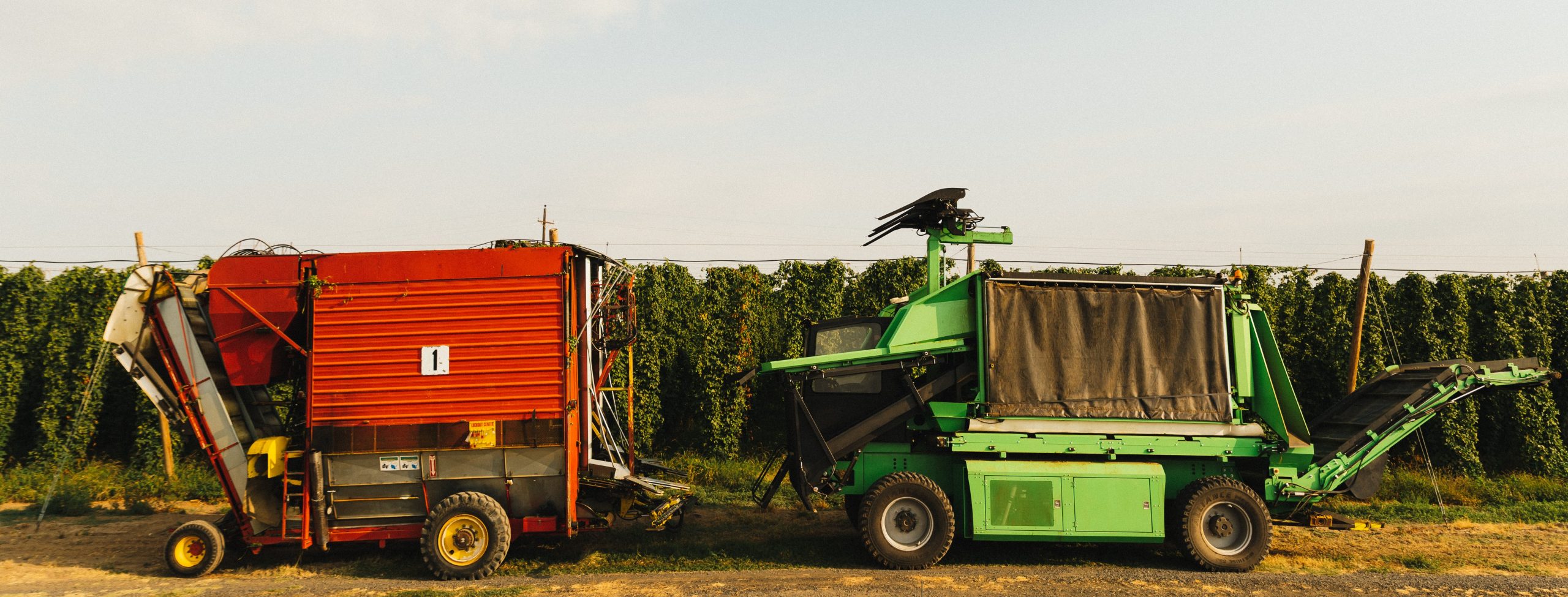2023 Year in Review with Hopsteiner
As we bid farewell to another transformative year, it’s time to reflect on the remarkable journey that was 2023. Join us as we take a retrospective dive into the pivotal moments, groundbreaking innovations, and notable achievements that have shaped our path over the past twelve months at Hopsteiner. From embracing sustainability initiatives to navigating industry shifts, there was a lot to be proud of all thanks to our Hopsteiner team.
PNW Climate Conditions
Like any year, 2023 had its challenges, but despite adverse weather conditions, the overall crop yield and chem specs came in average to above average. Weather is always the most significant factor when harvesting any agricultural product. Still, hops are particularly finicky with cold/wet weather, and this year, the PNW experienced exceedingly low temperatures and late rain throughout early spring. In May, temperatures were a series of highs and lows, with the lows falling well below average. Mixed weather continued throughout June and early July, causing some early bloom in aroma varieties. Inconsistent weather typically brings disease and insect pressure challenges, but all potential issues were kept at bay with preventative fungicides, beneficial insect releases, and miticide rotations.
As we moved through the harvest season, we were hit with unseasonable rain showers and cooler-than-average temperatures, causing kilns to run a bit longer but not stopping the show. Overall, the late rain did not affect the quality or production time of most aroma and alpha varieties, leading to a great ’23 hop crop.
2023 Hop Stats
 Total PNW hop production came in at 104 million pounds, up 2% from 2022 at 102 million pounds with an average yield of 1,915 pounds per acre, up 221 pounds from 2022.
Total PNW hop production came in at 104 million pounds, up 2% from 2022 at 102 million pounds with an average yield of 1,915 pounds per acre, up 221 pounds from 2022.
All three major growing regions (WA, OR, & ID) experienced acreage cuts as the market tried to balance out. Washington State remains the top growing region making up 74% of the U.S.’s hop crop, with an acreage decrease from 42,762 to 38,851 in 2023, down 9%. Idaho made up 16% of the U.S.’s total hop crop with an acreage decrease from 9,267 in 2022 to 8,638 in 2023, a 7% decrease in total. Oregon experienced the highest decrease in acreage falling from 7,787 in 2022 to 6,822 in 2023.
Public varieties remained static in 2023, while proprietary varieties decreased overall by 11% respectively. Alpha varieties made up roughly 25% of total acreage in the U.S. Aroma varieties made up 48% and dual-purpose varieties made up 27% of total acreage, with alpha varieties being the only category to experience growth in acreage.
Hop Selection
 The Hopsteiner Breeding Program’s latest experimental variety Alora™ – formerly HS17701, was on display for aroma and visual grading, winning over all who rubbed, with exceptional reviews. Alora™ boasts intense peach, yuzu fruit, apricot, and sweet melon aromas with high-bound 3MH thiols, lending those aromas to finished IPAs and Lagers alike. Also new from the Hopsteiner Breeding Program is HS16660, a variety that experienced its first semi-commercial harvest this crop year, also being well-received amongst brewers who gave it a rub. We would like to thank all our customers and friends for taking the trip out here, for hop selection, touring the farms, and for great memories!
The Hopsteiner Breeding Program’s latest experimental variety Alora™ – formerly HS17701, was on display for aroma and visual grading, winning over all who rubbed, with exceptional reviews. Alora™ boasts intense peach, yuzu fruit, apricot, and sweet melon aromas with high-bound 3MH thiols, lending those aromas to finished IPAs and Lagers alike. Also new from the Hopsteiner Breeding Program is HS16660, a variety that experienced its first semi-commercial harvest this crop year, also being well-received amongst brewers who gave it a rub. We would like to thank all our customers and friends for taking the trip out here, for hop selection, touring the farms, and for great memories!
Research and Development
The Hopsteiner Breeding Program focuses on improving hop quality among commercially available varieties and continues to pursue disease-resistant traits for better overall agronomics. Our agronomists in the breeding program have significantly improved field design for our experimental varieties allowing for optimum growing practices for each variety. This expansion in our experimental yards has allowed for more statistical power when selecting new varieties to advance in our vetting process. Previously, hops in the pre-commercial phase were planted in one location. They have now expanded to two separate locations, simulating different growing environments, and exposing potential issues growers may have in different regions. A new greenhouse facility will be constructed to support propagation of commercial and experim ental varieties for expansion of virus-free planting and streamline our seedling and germination procedures.
ental varieties for expansion of virus-free planting and streamline our seedling and germination procedures.
The research and development team attended the Plant and Animal Genome Conference last January. Hopsteiner Scientists continue to lead the industry in genomics and bioinformatics and will be publishing the hop genome this year for humulus lupulus. Over the last year the team has been successful in identifying markers that correlate to aroma traits and disease susceptibility allowing us to expand our breeding program even further. Streamlined markering systems of males have allowed for faster and earlier results when predicting variety outcomes. The research and development team will continue to make great strides towards sustainable practices setting Hopsteiner apart from the rest.
New and Notable at Hopsteiner
In the last year, Hopsteiner invested in an in-house pesticide laboratory with top-tier equipment and highly skilled employees. Previously this testing was outsourced and was not time efficient nor sustainable. Sample results in the past ranged anywhere from weeks to months to receive, whereas now we receive results in as little as a few days. Using industry standards and quality control measures our chemists have developed hop specific methods that ensure end results are repeatable and accurate. The new Gas Chromatography-Mass Spectrum Triple Quadrupole and Liquid Chromatography-Mass Spectrum Triple Quadrupole (GCMSMS and LCMSMS respectively) machines have allowed our team of scientists to test down to 0.01 PPM confirming the pesticide residue levels for all lots are within acceptable ranges. Our technicians in the pesticide lab work alongside our Quality Assurance, Research and Development, and Agronomy teams to develop effective integrated pest management programs so growers can apply pesticides in a way that results greatest efficacy with the lowest detection levels once the samples reach the laboratory.
 As new pesticides are approved for use on hops, our laboratory will begin testing to quantify those levels. In 2024 non-hop related pesticides will be added to our database for detection to ensure there is no cross-contamination due to neighboring orchards or vineyards.
As new pesticides are approved for use on hops, our laboratory will begin testing to quantify those levels. In 2024 non-hop related pesticides will be added to our database for detection to ensure there is no cross-contamination due to neighboring orchards or vineyards.
Hopsteiner has invested significantly in the development of a laboratory to detect and identify hop oils, terpenes, and sulfur (thiol) compounds in hops. The new equipment provides enhanced testing capabilities for a more total oil composition. With our end goal being enhanced reporting, identification of new and unique hop aromas in our breeding program and optimizing harvest windows and kilning/conditioning regimens.
Our laboratory at Hops Extract Corporation of American Laboratories continues to follow industry standard testing for hop extract and all 30 of our downstream products. Technicians at the HECA laboratory have started collecting and sampling larger batch sizes for better quality control measures. Collaborating with four separate ring analysis programs. Hopsteiner is now the main provider of standards to the ASBC for the various downstream products.
The Hopsteiner harvest laboratory continues to improve both its pre-harvest and during-harvest testing. The sampling process for all fields is the same to keep results consistent. Cone samples are dropped at the lab where alpha, beta, HSI, cone weight, and other variable tests are performed to ensure all varieties are of exceptional quality. All data collected before and during harvest is provided to growers to aid in their harvest timing decision. After harvest data is analyzed and we can assess each variety and find areas to improve our yields.
Sustainability Efforts
As a certified producer of organic agriculture, our team has taken the reins in understanding the requirements necessary for growing organically. Like any commercially grown agricultural product, inputs such as water, fertilizer, pesticides, and fuel are required. Each input is essential to a crop’s success, but in turn, may leave an impact on the environment. Today, many hop varieties are available for commercial use and can vary greatly in agronomic traits such as yield, disease resistance, and nutrient use efficiency. The variation of agronomical traits amongst hop varieties can have a significant impact on the total amount of inputs required for commercial hop production and ultimately influence overall production sustainability. Understanding how to grow our hops differently to accommodate the organic market has significantly bettered our overall growing practices for regular hop crops.
 Carbon Dioxide equivalent emissions (CO2 equivalents), commonly called Carbon Footprint, are often used to quantify the environmental impact of crop production inputs. Greenhouse gas emissions are associated with the formulation, packaging, and application of these respective inputs. We measured these inputs by compiling hop production records, cone yields, and alpha-acid yields across multiple varieties to determine the Carbon Footprint associated with each variety. What we found was remarkable.
Carbon Dioxide equivalent emissions (CO2 equivalents), commonly called Carbon Footprint, are often used to quantify the environmental impact of crop production inputs. Greenhouse gas emissions are associated with the formulation, packaging, and application of these respective inputs. We measured these inputs by compiling hop production records, cone yields, and alpha-acid yields across multiple varieties to determine the Carbon Footprint associated with each variety. What we found was remarkable.
Our data found significant differences between hop varieties based on the Total CO2 Equivalents per hop pound produced. This study resulted in comprehensive data sets from total commercial hop production inputs and carbon footprints for multiple commercially available hop varieties that can be used by brewers to select better ingredients with more environmental value.
We are proudly now Bee Better certified. To protect and expand pollinators’ habitat, we have planted various crops in one of our organic fields that will support biodiversity conservation for regenerative agriculture practices. We aim to provide brewers with a standard sustainability metric to assist in making more sustainable choices amongst available hop varieties.
Insights into 2024
All signs indicate a reduction in acreage to help right-size production to market demand. Total acreage estimated for 2024 is 44,425 total acres, down from 54,311 in 2023 and close to what acreage was in 2015. Total production is estimated to be right around 84M lbs, close to 2015 and 2016 volumes respectively. 80M lbs was a common number heard in conversation during the convention that farmers and suppliers aim to hit as a good base level to help market correction.
We want to express our sincere gratitude to everyone who has been a part of Hopsteiner’s journey in 2023. Thank you for being a valued member of the Hopsteiner community. Here’s to a great year ahead!

